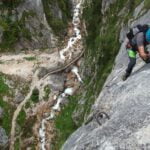Rock climbing requires trust between climbers. As you ascend a towering cliff or conquer a challenging boulder, you rely on your climbing partner to secure your safety. It’s a thrilling and exhilarating experience that demands a deep level of trust and communication. But rock climbing is more than just a sport; it fosters a connection with nature that is truly awe-inspiring. With each grip, every step, and every glimpse of the breathtaking vistas from the summit, climbers become one with their natural surroundings. In this article, we delve into the fascinating world of rock climbing and explore the captivating facts that make it such an incredible adventure.

Facts About Rock Climbing
Rock climbing has captured the hearts of adventurers for centuries. Its roots trace back to the Bronze Age, making it one of the oldest hobbies in the world. Imagine being a part of a sport with such a rich history, where you can connect with climbers from ancient times as you embark on your own thrilling journeys. The first recorded climb using specialized gear took place in the early 1930s, marking a pivotal moment in the evolution of this daring endeavor.
But rock climbing isn’t only about conquering cliffs; it’s an activity that engages your entire body. Unlike many other sports, rock climbing requires coordination, strength, and endurance from head to toe. As you scale the rocky heights, every muscle in your body comes alive, fueling your exhilarating ascent. It’s a full-body workout like no other, pushing your physical and mental limits in the pursuit of achievement.
In 2020, rock climbing achieved a significant milestone, making its debut at the Tokyo Olympics. The world watched in awe as athletes defied gravity, showcasing their extraordinary skills and determination on the global stage. The inclusion of rock climbing in such a prestigious event further solidifies its status as a sport that demands respect and admiration.
Now, let’s dive into the different types of rock climbing that enthusiasts can explore. There are eight distinct styles, each offering its own unique challenges and thrills. Bouldering, a style that originated in Fontainebleau, France, involves climbing shorter routes without ropes or harnesses. It’s like solving a puzzle with your body, using carefully chosen movements to navigate complex rock formations.
Sport climbing, on the other hand, takes climbers to vertical cliffs, where they ascend using bolts and fixed anchors for protection. It’s a dance between human strength and nature’s unforgiving terrain, pushing climbers to master technical skills while maintaining focus and composure.
Ice climbing embraces the frozen wonders of winter, as climbers ascend icy walls and frozen waterfalls. It requires specialized equipment and a whole new level of courage to face the cold and the precarious nature of the ice. Each type of rock climbing has its own allure, attracting a diverse community of adventurers seeking challenges and a deep connection with nature.
Throughout the ages, rock climbing has evolved into a captivating and multidimensional sport, offering endless opportunities for personal growth and discovery. From its ancient beginnings to its thrilling debut at the Olympics, the journey of rock climbing continues to inspire and captivate the imagination of adventurers worldwide.
So, whether you’re just starting or a seasoned climber, immerse yourself in the world of rock climbing. Unleash your inner explorer, challenge your boundaries, and embrace the thrill of defying gravity. Discover the wonders of this awe-inspiring sport and become part of a historical legacy that stretches back through the ages. Get ready to climb to new heights, both physically and mentally, as you embark on an unforgettable adventure.
“Rock climbing is not just a sport; it’s an embodiment of human perseverance and a testament to the indomitable spirit of exploration.”
Facts about rock climbing are always fascinating to learn. Did you know that there are fun facts about mountain climbing? From conquering breathtaking peaks to overcoming physical and mental challenges, mountain climbing is an exhilarating adventure. If you’re curious to know more, check out these Fun Facts About Mountain Climbing. If you’re particularly interested in rock climbing, we’ve got you covered with 10 Interesting Facts About Rock Climbing and 5 Interesting Facts About Rock Climbing. Rock climbing is not only thrilling, but it also offers numerous Benefits Of Rock Climbing. Whether you are a beginner or a professional, there are professional rock climbing organizations to guide and support you in your journey. Exploring the world of rock climbing is not limited to adults only. We have Facts About Rock Climbing For Kids as well. So, if you are ready to delve into the fascinating world of rock climbing, click on these links and discover more about this incredible sport:
- Fun Facts About Mountain Climbing
- 10 Interesting Facts About Rock Climbing
- 5 Interesting Facts About Rock Climbing
- Benefits Of Rock Climbing
- Professional Rock Climbing Organizations
- Facts About Rock Climbing For Kids
So, what are you waiting for? Start exploring the thrilling and awe-inspiring world of rock climbing!
Rock climbing requires trust between climbers
Rock climbing is not just a test of strength and agility; it is also a profound exercise in trust. As climbers ascend the towering cliffs and boulders, they rely on their climbing partners to belay them safely, communicating their every move and providing crucial support. This trust between climbers is the foundation upon which successful climbs are built.
Imagine yourself poised at the base of a magnificent rock wall, preparing to embark on a daring ascent. You stand side by side with your climbing partner, your lives interwoven by a tether of trust. Their knowledge and expertise in handling the rope, securing anchors, and assessing potential hazards instills a sense of confidence in you. Without this trust, the climb would be a perilous endeavor.
Each step you take, each handhold you grasp, requires unwavering trust in your climbing partner. They are your lifeline, ensuring your safety as you navigate the vertical terrain. Every movement is choreographed through clear and effective communication, creating a seamless dance of trust and reliance. The bond between climber and belayer is paramount, as it bridges the gap between fear and triumph.
In the sport of rock climbing, trust extends beyond the immediate partner to include the entire climbing community. Trust is implicit in the grading of climbing routes, as climbers trust that the assigned difficulty accurately reflects the challenges they will face. Trust is also crucial in the development and maintenance of climbing equipment, as climbers place their lives in the hands of well-designed and thoroughly tested gear.
But trust is not limited to physical aspects of climbing—it permeates the mental and emotional realms as well. The courage to push past one’s limits and face the unknown is grounded in the trust gained from experience and knowledge. Trust allows climbers to conquer their fears, forge bonds with their climbing partners, and discover the depths of their own capabilities.
As writer Albert Schweitzer once said, “In everyone’s life, at some time, our inner fire goes out. It is then burst into flame by an encounter with another human being. We should all be thankful for those people who rekindle the inner spirit.” In the world of rock climbing, these encounters are numerous, and the flames they ignite are the bonds of trust between climbers.
So, the next time you observe a climber ascending a wall with grace and determination, remember that their journey is not just a physical one—it is an embodiment of trust. It is a testament to the power of the human spirit when fueled by trust between climbers. And perhaps, it may inspire you to embark on your own adventure, where trust awaits, ready to guide you to new heights.
Trust is the lifeline that connects climbers on their ascent, allowing them to conquer challenges with confidence and grace.
Trust bridges the gap between fear and triumph, enabling climbers to push past their limits and discover their true potential.
In the world of rock climbing, trust extends beyond the immediate climbing partner to include the entire community and the gear on which climbers rely.
The journey of a climber is not just physical—it is a profound exercise in trust, igniting the inner flame and guiding them to new heights.
Rock climbing fosters a connection with nature
Rock climbing isn’t just about reaching new heights or conquering challenging routes; it’s also a remarkable journey that allows climbers to forge a deep connection with nature. When you strap on your climbing shoes and harness, you’re not just embarking on a physical adventure – you’re immersing yourself in the breathtaking beauty of the outdoors. As an experienced climber and outdoor enthusiast, I can attest to the transformative power of rock climbing when it comes to fostering a profound appreciation for nature.
With every ascent, climbers are rewarded with awe-inspiring views of majestic landscapes and stunning rock formations. Whether you find yourself clinging to the jagged edges of a cliff or scaling a towering boulder, you can’t help but be captivated by the raw and unfiltered beauty that surrounds you. The rugged terrain, the vibrant hues of nature, and the sheer magnitude of the environment all combine to create an unparalleled sensory experience.
But it’s not just about the visuals. Rock climbing engages all your senses. As you touch the rough textured surface of the rocks, you become acutely aware of the natural world around you. The sound of wind rustling through the trees and the distant calls of birds create a symphony that accompanies your ascent. The crisp scent of fresh air and the earthy aroma of the rocks further connect you to the natural elements. Every moment spent on the rock face serves as a reminder of the intricate beauty and delicate balance of the ecosystem you find yourself in.
quote: “Rock climbing allows us to peel back the layers of modern life and immerse ourselves in the raw and unaltered beauty of nature.”
One of the exciting aspects of rock climbing is that it affords climbers the opportunity to explore diverse outdoor environments. Whether you’re scaling the granite walls of Yosemite National Park, navigating the limestone crags of Thailand, or conquering the icy peaks of the Himalayas, each location presents its own unique wonders. The climbing community is fortunate enough to have access to some of the most awe-inspiring places on Earth, and rock climbers have the privilege of being able to intimately interact with these natural wonders.
But with privilege comes responsibility. As climbers, it is crucial that we prioritize the preservation of the environments we venture into. Responsible climbing practices, such as minimizing impact, respecting wildlife, and preserving the integrity of the rock, are essential to ensure that future generations can also enjoy these natural treasures. Rock climbers must strive to leave no trace, so that the beauty of nature remains untouched for all those who come after us.
quote: “As climbers, we have a unique opportunity to serve as stewards of the environment, protecting and preserving the delicate balance of nature.”
In conclusion, rock climbing is not solely a physical activity; it is a gateway to a profound connection with nature. Through the sport, climbers are able to immerse themselves in the stunning landscapes, engage their senses, and appreciate the intricate beauty that surrounds them. However, with this privilege comes responsibility. It is incumbent upon climbers to act as environmental stewards, practicing responsible climbing techniques to ensure that the beauty of nature remains preserved for future generations.
quote: “Embark on the thrilling adventure of rock climbing and discover the awe-inspiring connection with nature that awaits you.”
FAQ
Question: How important is trust between climbers in rock climbing?
Answer: Trust between climbers is crucial in rock climbing as it ensures safety and provides support during challenging climbs. Effective communication and trust between climbing partners can make a significant difference in the success of a climb.
Question: Does rock climbing foster a connection with nature?
Answer: Yes, rock climbing fosters a deep appreciation for nature as climbers immerse themselves in beautiful outdoor environments. Exploring breathtaking landscapes and testing physical and mental abilities can create a strong connection with nature.
Question: What are the five main types of rock climbing?
Answer: The five main types of rock climbing are free climbing, mountaineering, aid climbing, bouldering, and deep water soloing. Each type offers unique challenges and techniques.
Question: Can rock climbing be practiced both indoors and outdoors?
Answer: Yes, rock climbing can be practiced indoors on artificial walls or outdoors on natural rock formations. This allows individuals to choose the environment that suits their preferences and skill level.
Question: What are some mental and physical health benefits of rock climbing?
Answer: Rock climbing has numerous mental and physical health benefits, including improved strength, flexibility, and problem-solving skills. It can also be a challenging and rewarding activity that pushes individuals to their limits and helps overcome fears and obstacles.
- China II Review: Delicious Food & Speedy Service - April 17, 2025
- Understand Virginia’s Flag: History & Debate - April 17, 2025
- Explore Long Island’s Map: Unique Regions & Insights - April 17, 2025
















